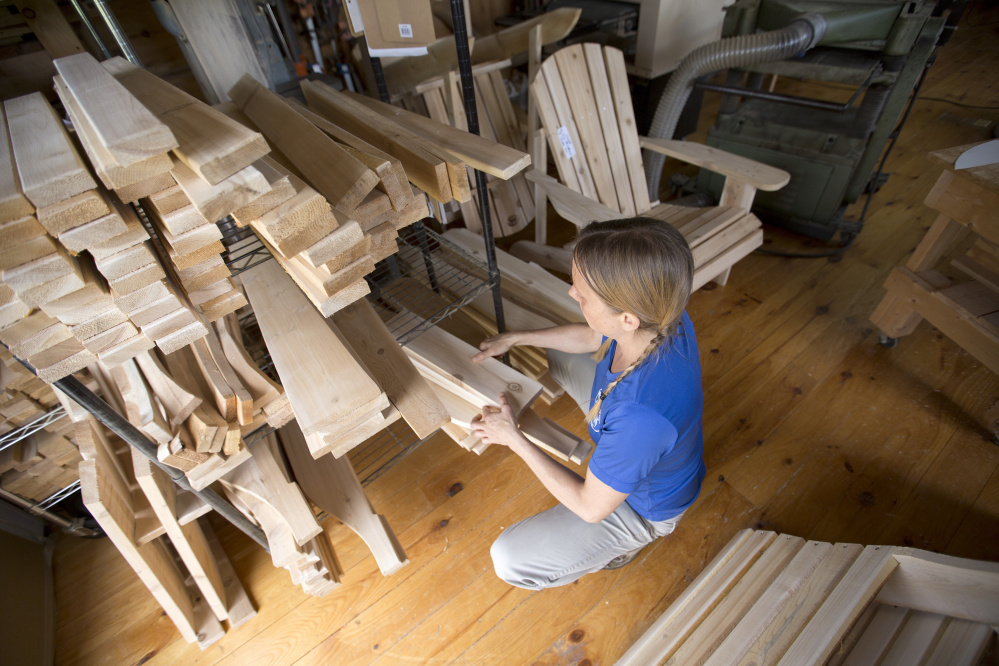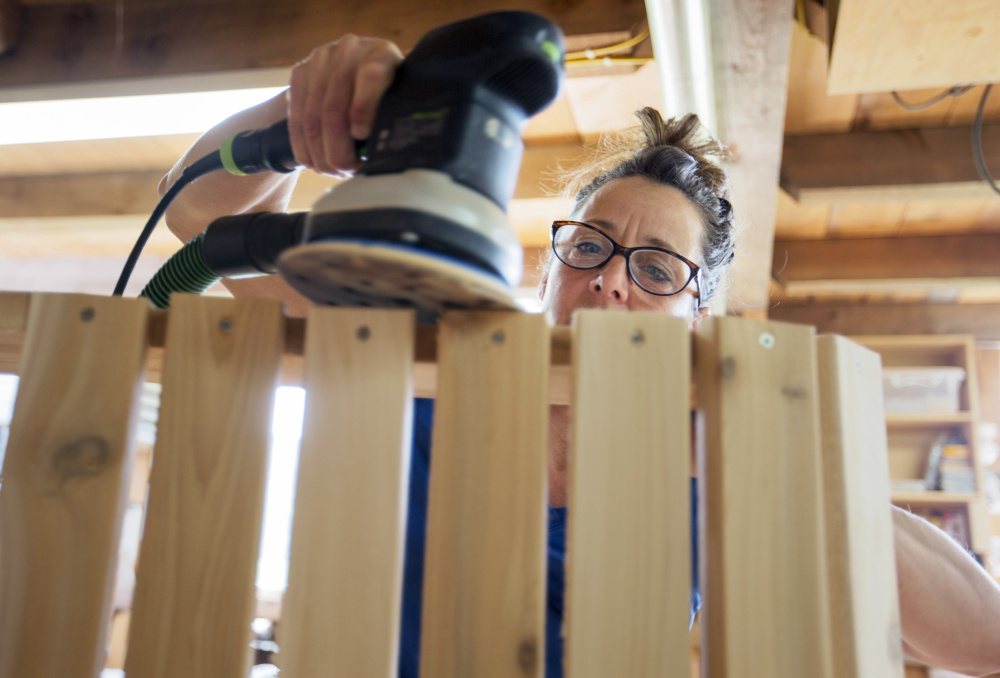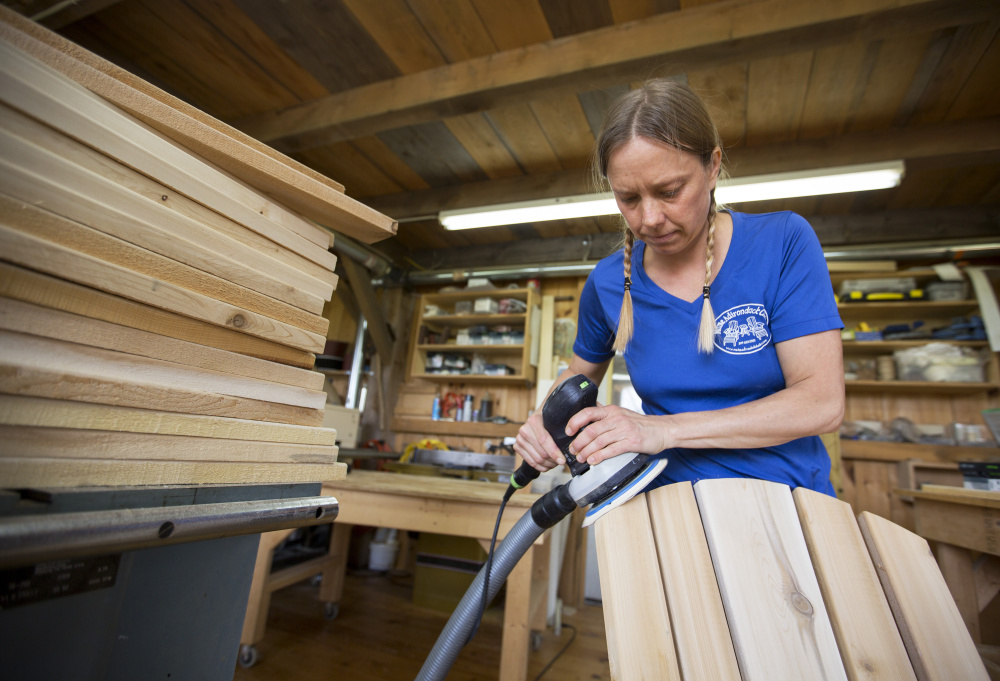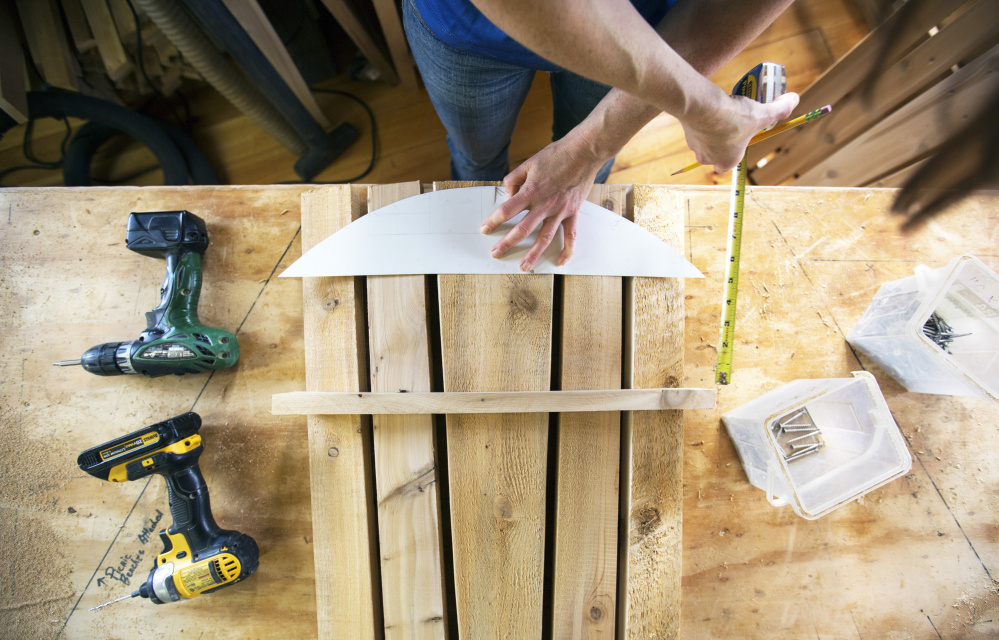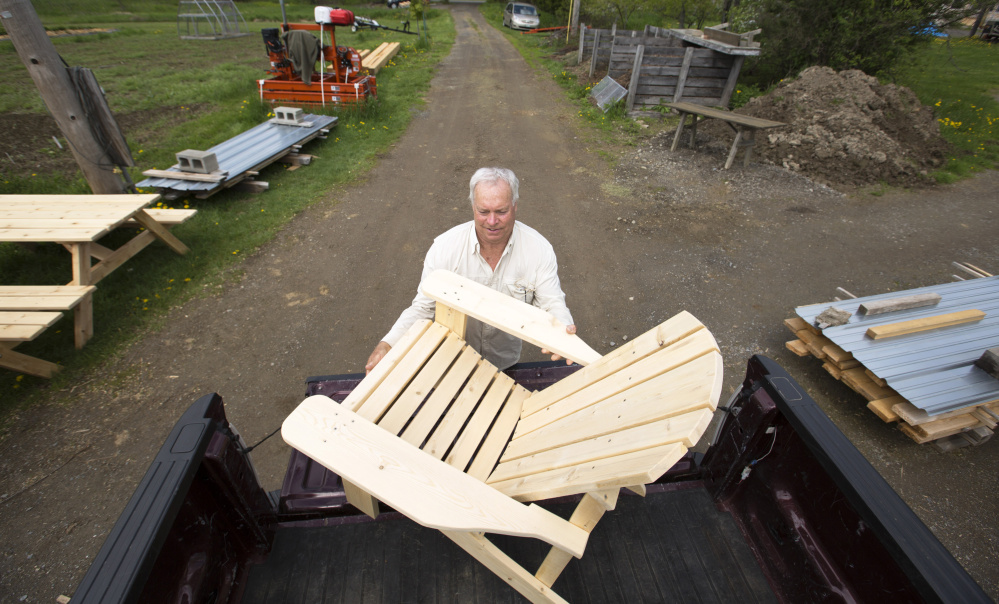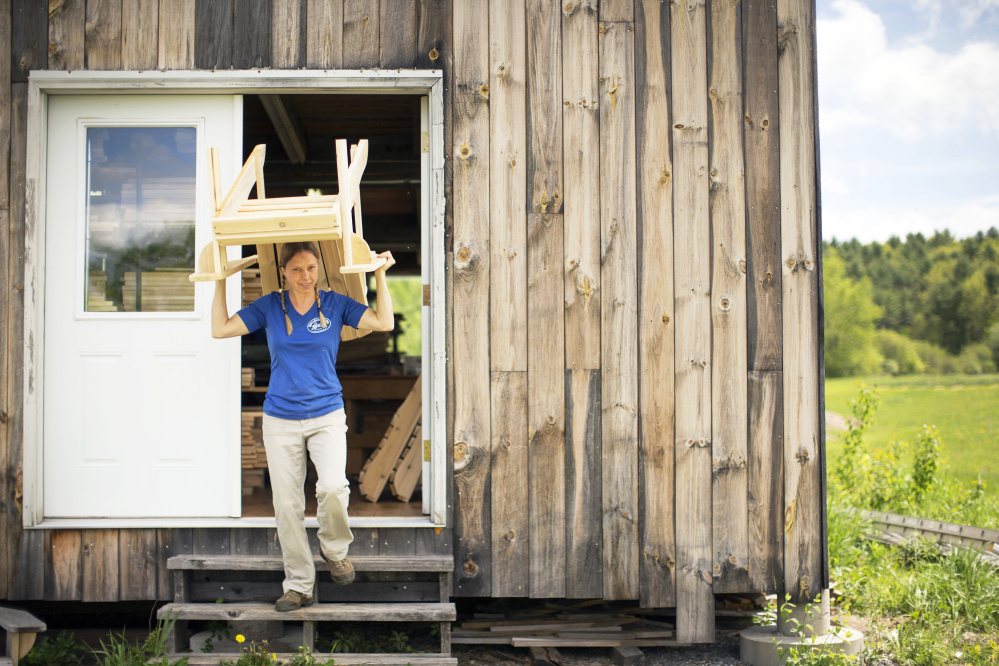Adirondack chairs are emerging from hibernation all over Maine. Cheery reds, peaceful pastels, natural woods, classic dark green, all each wide enough for both a book and a drink. Sitting in them, a person’s forearms naturally assume the position of royalty on a throne, the garden or lawn the domain.
Garden thrones can come cheap. At a big-box store, or even beloved Maine chain Renys, you can pick up one of these chairs in molded plastic for as little as $17.98. Maybe even made in America. Or you could order a chair from Rob Lemire’s Vassalboro-based company, Maine Adirondack Chairs, for $110. Which would get you something handmade from a durable wood, white cedar that’s most likely from Maine or Canada, but in any event, not far away. Or you could buy a more expensive version ($299) made out of a form of recycled plastic “lumber” at say, L.L. Bean, also made in the United States.
In honor of Memorial Day weekend, the marker in time when even the ultimate late-snow-fearing pessimist drags out the garden furniture, we set out to answer a nagging question: What’s the better choice, sustainability wise? Should those of us who fell for the allure of a cheap plastic Adirondack chair feel guilty?
We had a strong hunch about what the answer would be, and uncovered some math and Life Cycle Analysis to substantiate it. But more than once we were told that this is an easy question to ask but a hard one to answer, and we heard some surprising opinions from experts, including that how much we like our chairs, be they plastic or wood, is a factor in the sustainability equation.
HE JUST WANTED TO SIT DOWN
First, a quick history lesson. The first Adirondack chairs were, like Lemire’s, wooden, unsurprising given the era. According to the museum of the Adirondack region in upstate New York, the Adirondack Experience, a man named Thomas Lee invented the basic shape in 1903.
Frustrated by the lack of comfortable chairs at his family cottage on Lake Champlain, he began nailing boards together. He had his extended family try out the different versions right there on the lawn before arriving at consensus as to which slant was most comfortable in terms of back (and bottom) support. Lee used just a single, wide pine board for the back and made wide armrests.
One of Lee’s hunting pals, a carpenter in Westport named Harry Bunnell, needed work to get through the winter, and Lee suggested he try making and selling the chairs. Bunnell went into the chair business and built what he called (and patented) the Westport chair until 1930, using hemlock boards for the back rest. After that, others picked up the basic shape, but used slats for the back instead of a single board – slats being cheaper. The chairs were made widely throughout the Adirondack region and then spread to other parts of the country. By 1938, a New Jersey man had laid claim to a patent for what he called a lawn chair, which looked identical to today’s Adirondack chairs. Today there are patent holders for various versions, including a plastic folding version made by Adams Manufacturing, the Pennsylvania-based company that makes a “resin” chair sold by Lowe’s. Resin is a different way of saying plastic.
Rob Lemire does not have a patent. What he has is a well-worn pattern, which he’d bought, he doesn’t even remember where from, about 30 years ago. He moved to Maine in 2007 with plans to retire (foiled by gigs at Fedco and farming ventures with his partner, seed expert Roberta Bailey) but maybe do some woodworking.
“I thought I was going to be building kitchen cabinets,” he said. His plan was to be selective about what jobs he took. But he found a limited market for higher-end kitchen cabinets in Central Maine, so he pulled out that old pattern, which featured a nice soft curve in the seat. Almost “ergonomic,” he said. He and his staff, which has grown to three, all women from the area, developed some modifications along the way, like a slightly smaller version they called the Adirondack 90, which was downsized by about 10 percent to be more comfortable for women.
He hasn’t tried to drum up business, but an Instagram account got him some attention, including from Maine’s own Chilton Furniture, which asked him to build a custom version for their Freeport showroom. In 2016 he and his crew at Maine Adirondack Chairs made 400 chairs (and a lot of picnic tables, footstools, benches and the like).
Naturally, he prefers his chairs, made of cedar that he says is ultra durable and local. Or relatively so, he says it could be from northern Vermont or Canada but in all likelihood is from Maine (most of what he uses is milled here anyway, by Dewey’s Lumber and Cedar Mill in Liberty). Lemire would tell you to buy local, from Maine craftspeople whenever possible. “That is pretty important to me.”
Also pretty important to Matt Prindiville, the Maine-based executive director of Upstream Policy, a national environmental organization that focuses on such issues as ending plastic pollution.
“Maine wood chairs equal local renewable resources going to make durable products,” Prindiville said in an email. “That’s my kind of outdoor furniture.”
His understanding is that many plastic chairs are made from low-value plastic materials, that is, mixes of different types of polymers that have limited uses. It’s good to do something with those plastics, he said, but the chair represents the end of the road. It can’t be melted down and turned into some new object; it’s “one and done” because of that mixed polymer material it came from. Moreover, a “cheap” plastic chair is only as “cheap” as the price of oil, Prindiville said.
THE TRUE COST OF COMFORT
A life cycle analysis by the University of Florida’s School of Forest Resources & Conservation supplied us with the most useful data we could find to settle our debate on wood versus plastic Adirondack chairs. Part of an exercise intended for educational purposes, it compared the environmental costs of three different sets of outdoor furniture (each containing four chairs and a table), including a plastic resin set, cast aluminum and pine.

Adirondack chairs also come in the plastic variety
It breaks down the greenhouse gas emissions (carbon dioxide, methane and nitrous oxide) from each kind of set, factoring in the oil and natural gas extraction to make the plastics, the refining of those fossil fuels and then the environmental cost of manufacturing polypropylene – the little pellets of plastic that are then melted into a mold to make the furniture – and then of maintaining and disposing of it at the end of its life cycle.
It did the same for wood, including sustainable wood production (versus, say, the toll harvesting exotic woods like teak often takes on natural resources), lumber production, pressure treating the wood, maintaining it (with wood or stains) and disposing of it.
Running the numbers without using the data on pressure treating wood – since Lemire’s wood is not pressure treated – wood was the clear winner on carbon dioxide emissions, producing only 53 percent as many kilograms of carbon dioxide as the plastic resin set.
Andy Whitman, Director of Sustainable Economies Program for Manomet, the New England–based nonprofit that specializes in sustainability solutions, said he wasn’t surprised that wood “won” in the greenhouse gas emissions analysis but was somewhat surprised that the difference wasn’t more stark. “It’s sort of comparing apples and oranges, and you don’t always get the results you would expect. With all that petroleum in those chairs, you’d think the footprinting must be enormously different, like five times the greenhouse gas emissions, and it’s not.”
Whitman is considering some new lawn furniture purchases himself, and he said the study gave him pause because he’d thought of buying a metal set for durability and aesthetic. In the manufacturing stage alone, aluminum furniture had three times the emissions of the plastic and 20 times that of the wood. But it can be recycled, almost endlessly.
THE NEW PLASTICS
Left out of that life cycle analysis is another kind of outdoor furniture, that’s made with what is called HDPE lumber, high-density polyethylene. This is a product made from post-consumer materials that include old milk jugs and plastic bottles that once contained everything from water to detergent. It’s so durable that some companies that build furniture with it give multi-decade guarantees on their Adirondacks. There’s even an Amish-owned company in Kansas that sells Adirondack chairs made from this material, which it calls “poly lumber.”
L.L. Bean sells both wooden Adirondack chairs and its version of the HDPE chairs (which come from an Indiana vendor, according to a customer service representative). The HDPE chairs are more expensive and described as eco-friendly and with the promise that they will not “rot, warp, crack, splinter, absorb moisture or ever need painting.” They’re heavy enough to not tip over and if you browse the more than 100 reviews on L.L. Bean’s website, pretty popular (although some complain about the material and say the chair isn’t comfortable).
If the high-density polyethylene material had been included in that University of Florida life cycle analysis, Whitman said it would probably have beaten out wood for the title of “greenest” furniture. That’s because the original impacts of extracting fossil fuels and making plastics from them don’t “count” in this kind of life cycle analysis.
It should count, says Stephen Shaler, the director of the School of Forest Resources at the University of Maine in Orono. “The environmental burden is still there. You could argue that the impact of the milk jug is reduced, but you can’t ignore that all that extraction that created the milk jug wasn’t used for the chairs. The fact of the matter is, you still extracted the oil. And you are going to still have to dispose of the plastic, even if you are going to get a longer time of utility out of it.”
Shaler brought up another factor that needs to be included in a well-rounded life cycle analysis: how much use it gets.
“You have to define what the functional unit is,” Shaler said. In this case, it wouldn’t be the chair itself, it would be the number of hours of use the chair gets. Or the number of enjoyable hours you spend in the chair. Assume you buy two chairs, one plastic, one wood. You find the plastic one less comfortable, and therefore less functional.
“You never use the plastic one, so maybe it gets used for three hours, and the wood chair gets used for 30 hours,” he said. It’s getting ten times the use, and that increased functionality should be a factor in the overall equation about the chair’s impact. The chair you love will probably stick around the property longer than the chair you merely like. Shaler by the way, has metal, upholstered outdoor furniture. And “four Aubuchon plastic chairs that were on sale for $14 each,” he said. They’re for overflow crowds. Low cost, minimal use. “I didn’t look at the environmental cost,” he said. “That wasn’t part of my decision. Even though I do these things for a living.”
It’s Whitman’s hope, and a Manomet goal, that the world focuses on making more sustainable choices about materials up front in the future, planning for a circular or what’s known as a “cradle to cradle” economy. That is, we’ll invest in virgin materials only when we know they can be recycled, and reused endlessly, making a better decision about our resources upfront, rather than repurposing a bad one further down the line.
THE LIKABILITY FACTOR
Glen Brand, director of the Sierra Club’s Maine chapter, is no fan of the plastic chair, on multiple levels. There’s the pollution involved in how plastics are made (“highly toxic”) and the issues with environmental standards in many of the places they are made. “Many of them are made in China and India, and those are places that do not have environmental standards generally.”
“Then there is the pollution associated with transporting them to market,” he added. “And if they are cheap and they don’t last well, there is the problem with dealing with the garbage in Maine. They certainly can’t be burned.”
Interestingly, the University of Florida life cycle analysis turns the fact that plastic typically doesn’t break down in landfills, at least not for hundreds of years, into something of a plus. The greenhouse gas emissions data for the disposal of used treated wooden garden furniture is twice that of the resin set. While it’s true the resin, sitting inert in a landfill, produces less carbon dioxide as it decomposes (or rather, doesn’t decompose) that’s not exactly a long-term plus. The question there is, would you rather have something take up space in a landfill for hundreds of years, or break down more quickly while emitting more greenhouse gases? Brand would go with the wood, the more local the better. He has a pair of Adirondack chairs, wood, painted green, that he got on special at an L.L. Bean outlet some 10 years ago.
“There is nothing like the feel of wood, the aesthetic of it,” he said. “It’s a sensory pleasure.”
There’s that functionality that Shaler was talking about.
But as Brand drags them from the porch to the yard and back again to protective cover, every time he’s used them to soak up a day’s sun, he gets it. And his family does have a plastic table that they move around as needed outside. “I hate touching that table,” Brand said. But “I realize the convenience of just leaving the plastic stuff out all the time.”
“There are no pure choices when it comes to these products,” he added. “There’s no free lunch. Every product has some environmental downside.”
That’s the challenge of the modern age for the sustainably inclined, Manomet’s Whitman said. “You have these conundrums. You cannot fight every battle.” In terms of the battle of the lawn chair, there is one easy way to be more sustainable. Sit in whatever kind of chair you’ve got, plastic, poly lumber or wood, until it falls apart. Then replace it with something that took a lower toll on the environment to make and is still durable. Like wood. Rob Lemire says he’s got a pair of his old cedar chairs that have been outside 24/7 for 27 years. He tips them up on the wood pile in the winter, to keep the legs out of the wet.
“White cedar is a relatively soft,” Lemire said. “But it has unique properties because of its internal oils. It’s disease and rot resistant.” Pay attention to it and it can last, he said. But about his cheap competition? “I don’t think there is a plastic chair out there that you are going to see still standing in 25 years.”
Mary Pols can be contacted at 791-6456 or at:
Twitter: MaryPols
Send questions/comments to the editors.



